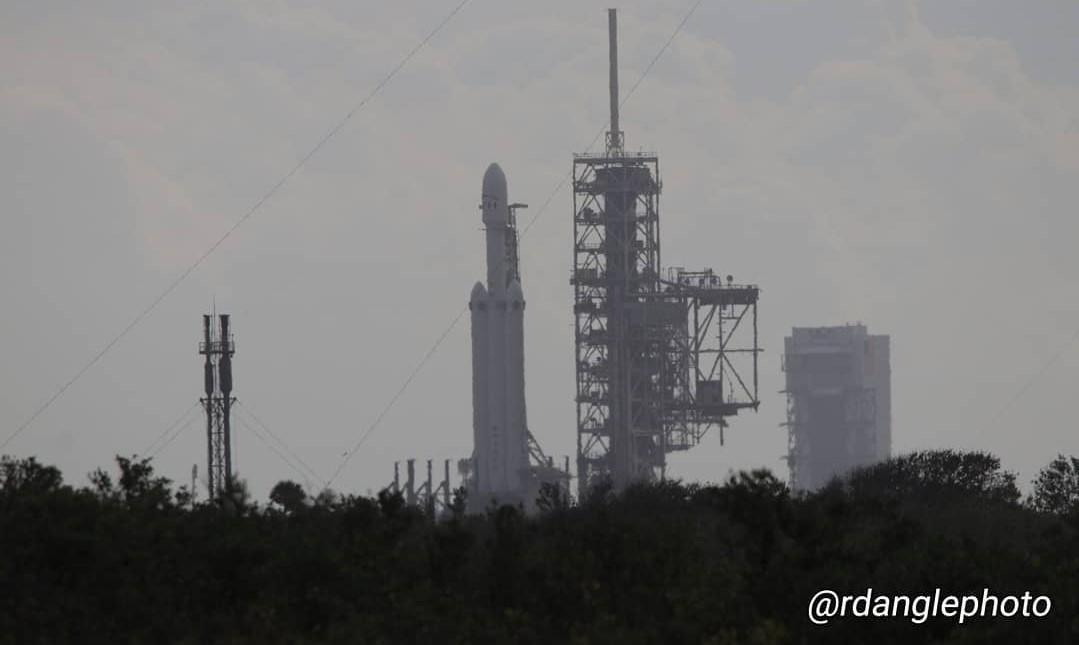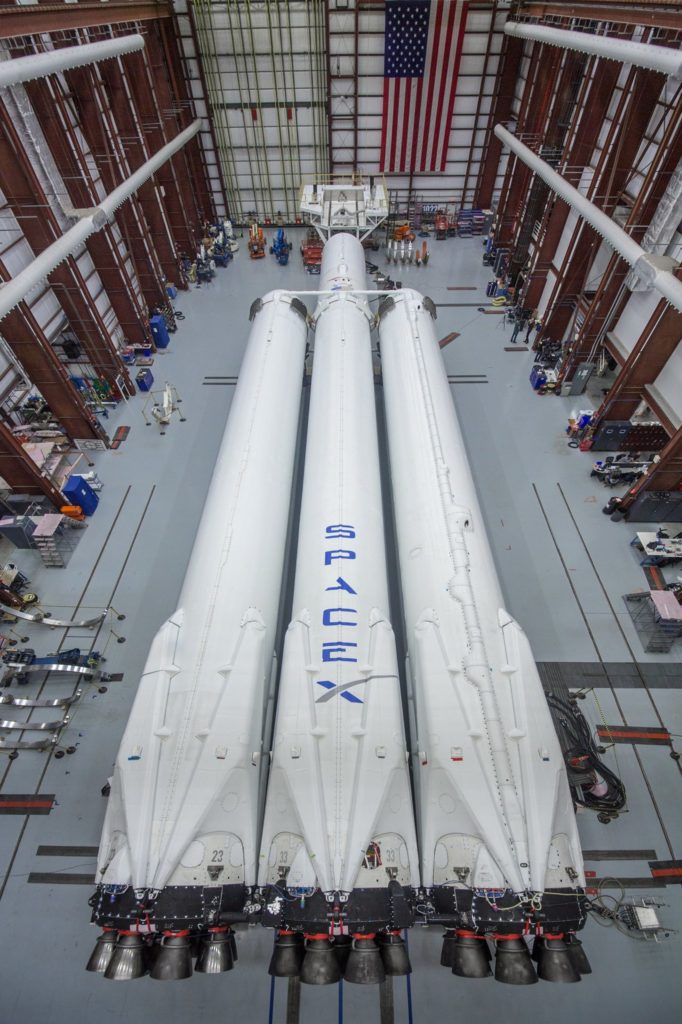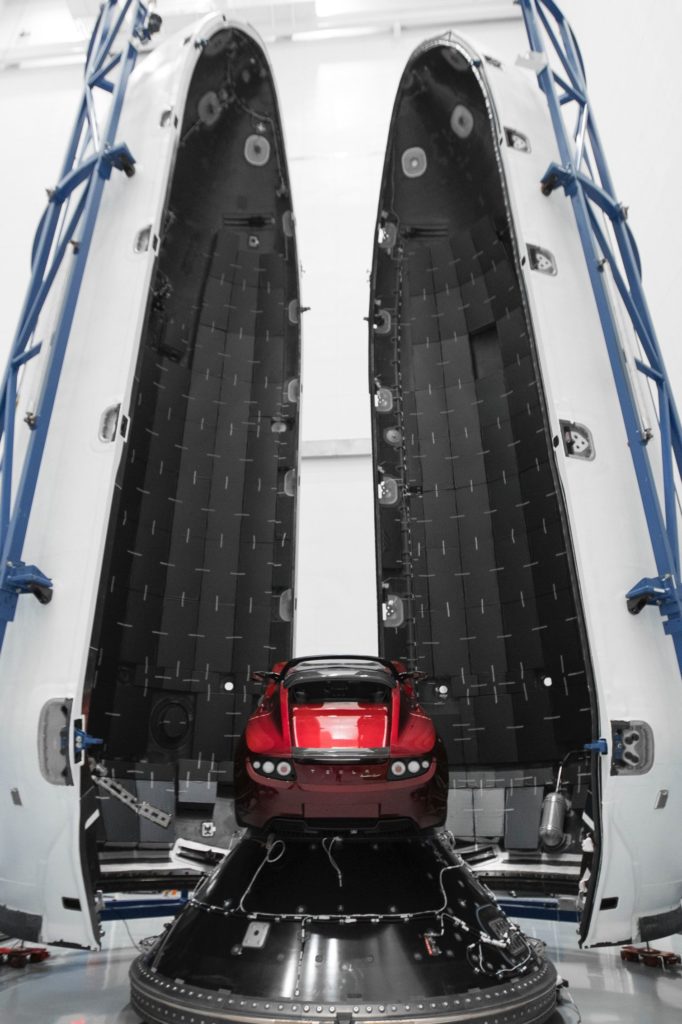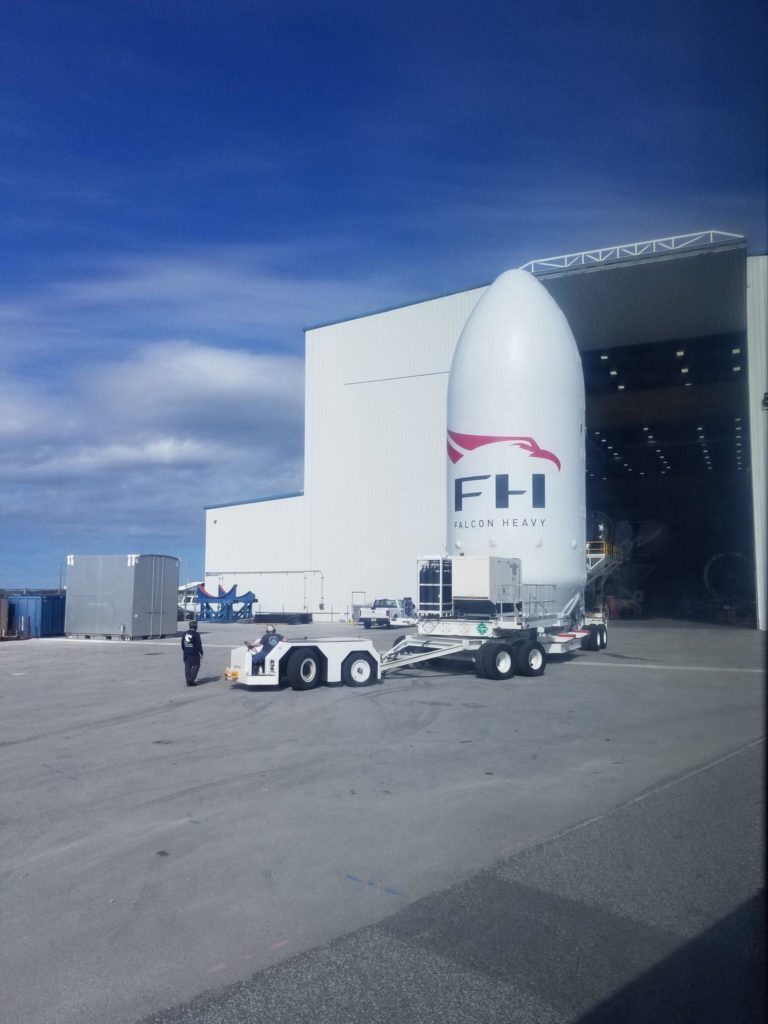

News
SpaceX Falcon Heavy goes vertical with Musk’s Tesla as launch nears
After approximately half a decade of concerted and less-than-patient waiting, long-time followers of SpaceX have, for the first time ever, seen SpaceX’s first completed Falcon Heavy rocket roll out to the launch pad and go vertical at the same complex that hosted every single Apollo moon landing, LC-39A.
This is a historic moment in SpaceX’s history, even if it culminates in nothing more than a quiet rollout and roll-back to the historic pad’s integration facilities. For at least several years, it has been a running (lighthearted) joke within the fan community that Falcon Heavy is permanently six months away from launch. Outside of the rocket company’s supporters, however, that fan humor gained a heavier tinge, and Falcon Heavy essentially became the strawman with which SpaceX detractors could ream the company’s greater (and even relatively minor) ambitions as over-promised, unrealistic dreams to one day also become permanently delayed. While seasoned spaceflight journalists rarely partook in the Falcon Heavy bashing, pop journalism and the titans of the global launch industry certainly took advantage of the apparent weakness as the preeminent example of SpaceX’s tendency towards delays. Even SpaceX’s conservative supporters understandably saw the significance when two customers ultimately chose to move their payloads elsewhere due to Falcon Heavy’s relentless delays.
Falcon Heavy went vertical at LC-39A for the first time today! Here’s a few shots (taken through much haze) from Playalinda Beach. pic.twitter.com/gsOL9tAfTN
— John Kraus (@johnkrausphotos) December 28, 2017
However, the reality was rather clear to those that followed the agile launch company and paid attention to the statements of its executive management, including CEO Elon Musk. Ultimately, Falcon Heavy was not a priority and was only ever going to capitalize upon a minority of the satellite launch industry, given the rarity of satellites heavy enough to need the massive vehicle. While Falcon Heavy would undoubtedly be invaluable for SpaceX’s grander ambitions of interplanetary exploration and transport, those ambitions simply did not compare in importance to solving Falcon 9 design and supply chain issues that caused the failures of CRS-7 and Amos-6. Nor were they more crucial than the launch company’s need for a stable cadre of trusting customers, simply upgrading the already-operational Falcon 9, or the perfection of first stage reusability – all of which would explicitly impact the utility of Falcon Heavy.

A panorama of LC-39A from late-November. Falcon Heavy will likely launch from this pad in January 2018. (Tom Cross/Teslarati)
SpaceX’s official July 2017 confirmation that Red Dragon had been cancelled further guaranteed that Falcon Heavy would only ever be a niche product, maybe even little more than a symbolic stopgap to fill a tiny industry niche and soothe delay-stricken nerves. SpaceX does have at least a handful of Falcon Heavy customers still hopefully awaiting its operational status, but it is quite clear that the company sees its value most as a method of both reassuring the world that its infamous delays are only temporary, as well as relatively economically fueling the development of a reusable super-heavy launch vehicle, expertise that would inevitably benefit the Mars-focused BFR as it too begins development. At a minimum, it will provide SpaceX’s launch, design, and manufacturing experts a sort of base of knowledge about building and operating rockets with ~30 or more first stage engines – the 2017 iteration of BFR is likely to sport 31. It’s also possible that Falcon Heavy could provide the margins necessary to allow SpaceX to attempt recoveries of Falcon’s second stage, a purely experimental effort that would feed directly into the development of the fully-reusable BFR upper stage the company hopes to build, BFS.
Thus, while Falcon Heavy’s inaugural launch may not be explicitly important to SpaceX’s near-term business strategy, it will in almost every way mark one of its first tailor-made steps towards Mars, perhaps both literally and figuratively. Rather humorously, SpaceX (or Elon Musk … probably just Elon Musk) has chosen to replace the boilerplate mass simulator often flown as a payload for inaugural launches of most launch vehicles (Falcon 9 included) with a rather unique mass simulator: Musk’s own first-generation Tesla Roadster. While it has yet to be specified what the specific destination of the second stage and Roadster are, nor what – if any – functional payload is to be included, Musk did suggest that the destination would be a “billion-year Mars orbit.” The nitpick here is hugely significant, as ‘simply’ launching the Roadster into a solar orbit at a similar distance to Mars (still an impressive accomplishment) would be decidedly less impressive than actually injecting the Roadster into orbit around Mars. Pictures released by SpaceX show no additional boost stages attached to the Roadster, so a Martian orbit would require Falcon Heavy’s second stage to coast in deep space for several months while generating enough power to prevent its propellant from freezing and maintain contact with ground control, especially in the rather likely event that SpaceX (and Musk) hope to acquire some rather absurd and iconic images from the inaugural launch and its space travels.
- The first-ever Falcon Heavy (sans payload and fairing) shown inside Pad 39A’s horizontal integration facility (HIF). (SpaceX)
- Elon Musk’s Roadster seen before being encapsulated in Falcon Heavy’s massive payload fairing. Below the Tesla is the payload adapter, which connects it to the rocket. (SpaceX)
- Finally, the fairing is transported vertically to the HIF, where it can be flipped horizontal and attached to its rocket. (Reddit /u/St-Jed-of-Calumet)
History and symbolism aside, it can now be said with utter certainty that Falcon Heavy is very real and is likely to launch very soon. The vehicle’s first-ever integrated rollout to Pad 39A is almost certainly intended only for “fit-checks,” a verification that the pad and brand new vehicle are meshing well together, but it is still the first time in the company’s history that FH visibly exists, and there can be little doubt that the photo opportunity was not taken advantage of. After fit checks are performed, likely over the course of a day or two, Falcon Heavy will be most likely be brought horizontal and rolled back into 39A’s integration facilities, where it will be prepared for its first full-up wet dress rehearsal (WDR) and static fire, possibly including the cautionary removal of the second stage and Roadster payload. Because the vehicle is inherently new, as are many of the upgraded ground systems needed to support it, bugs are highly probable along the road to launch. However, if the first WDR and static fire go precisely as planned, the first launch attempt can be expected to occur about a week later – maybe sooner, maybe later.
All things considered, SpaceX is clearly moving full speed ahead with Falcon Heavy’s launch preparations, and it seems highly probable that the company’s schedule will allow for January launch, even if minor issues mean that multiple WDRs or static fires are required. Elon Musk certainly hedged his bets earlier this summer by aggressively inflating the probability that Falcon Heavy fails on its launch pad, famously stating that a success in his eyes would be the vehicle clearing the pad without destroying LC-39A. In reality, SpaceX would not in a million years haphazardly risk the destruction of Pad 39A, and the company is almost certainly quite confident that the pad is at most marginally at risk of severe damage. One thing that Musk cannot be criticized for is the argument that one way or another, Falcon Heavy’s inaugural launch will be a sight to behold. While the payload may indeed be heading to or towards Mars, SpaceX still plans to attempt recovery of all three of Falcon Heavy’s first stages: both side cores are expected to land almost simultaneously at LZ-1’s two landing pads, while the center booster will follow a parabola out into the Atlantic for a landing aboard the droneship Of Course I Still Love You, truly a spectacle to behold regardless of success or failure.
My capture of @SpaceX #FalconHeavy making her #39A debut today. Taken with my Nikon D3300 with 300mm lens from the Canaveral National Seashore Vista 8. I must admit I have enjoyed watching the reactions to seeing it on the pad. My reaction… WHOA @NASASpaceflight @lorengrush pic.twitter.com/fEntFCwCO8
— Julia Bergeron (@julia_bergeron) December 28, 2017
Follow along live on Twitter and Instagram as our launch photographer Tom Cross documents Falcon Heavy’s last steps along its journey to first flight, as well as Falcon 9’s imminent launch of the mysterious Zuma payload, currently NET January 4.
Cover photo courtesy of spaceflight fan and photographer Richard Angle. Follow him on Instagram at @rdanglephoto!
Elon Musk
Elon Musk confirms Grok 4 launch on July 9 with livestream event
The rollout will be accompanied by a livestream at 8 p.m. Pacific Time.

Elon Musk has officially confirmed that Grok 4, the latest version of xAI’s large language model, will launch on July 9. The rollout will be accompanied by a livestream at 8 p.m. Pacific Time, hosted on xAI’s official account on X.
xAI goes straight to Grok 4
Back in May, leaks indicated that xAI was getting ready to ship Grok 3.5. Considering Musk’s recent comments, however, it appears that the artificial intelligence startup would be focusing on the large language model’s fourth iteration instead. As noted in a Financial Express report, users on X have sighted references to Grok 4 in the lead up to the update’s launch, such as “grok-4-prod-mimic” and “Grok 4 Code.”
Musk’s Grok 4 announcement comes as AI competition intensifies between major players including OpenAI, Google, and xAI. With Musk’s Colossus supercomputer fully operational in Memphis, xAI appears to be accelerating its AI product roadmap.
Musk pushes Grok toward political neutrality
Grok 4’s launch also follows a recent controversy involving political bias, as noted in a CNN report. Last week, Grok responded to a user on X stating that political violence in the U.S. since 2016 had come more from the political right than the left. The chatbot noted in a later reply that its answer was based on information from sources like Reuters, the Journal of Democracy, and University of Maryland studies.
Musk stated that Grok’s response was a “major fail.” “Major fail, as this is objectively false. Grok is parroting legacy media. Working on it,” he wrote in a post on X. By the end of June, Musk noted that he was “grinding all night with the xAI team” and that they were making “good progress.” He also stated that the model “Will be called Grok 4. Release just after July 4th. Needs one more big run for a specialized coding model.”
News
Tesla opens massive solar Supercharger station in California
The Supercharger opened to customers ahead of Fourth of July weekend, while Tesla continues phase two of construction on the site.

Tesla has officially launched the first several Supercharging posts at a massive station in California, notably including solar canopies and grid-scale batteries to offer completely renewable charging.
Last week, Tesla announced on X that it opened the first 84 Supercharger stalls of a planned 168-stall station in Lost Hills, California. Additionally, the massive Supercharger project features 11MW of solar canopies and 10 Megapack batteries for off-grid charging powered entirely by solar energy.
Tesla completed the first phase of the project just days ahead of the busy Fourth of July holiday weekend, adding that initial construction took just eight months. In addition to the remaining charging stalls, Tesla says it’s building a set of lounge areas, renderings of which can be seen below alongside current photos of the site.
Notably, the site also includes V4 charging posts for the company’s latest available charging speeds, and it’s located near the busy junction between I-5 and Highway 46 in Kern County.
“Thank you [Kern County] and [PG&E] for collaboration and approvals,” Tesla wrote in a follow-up post.

Credit: Tesla Charging | X

Credit: Tesla Charging | X

Credit: Tesla Charging | X

Credit: Tesla Charging | X
Tesla Supercharger Maps for North America, Europe, and Asia pic.twitter.com/0U5r0XRPyo
— TESLARATI (@Teslarati) July 2, 2025
READ MORE ON TESLA SUPERCHARGERS: Tesla launches ultra-fast V4 Superchargers in China for the first time
Testing at the LA Diner, plus Musk update on potential Tesla solar Gigafactory
The huge Tesla Supercharger station completed phase one of construction fairly quickly, especially given how long Tesla has been working on its unique Los Angeles diner, drive-in, and Supercharger location. Still, the company was seen performing some testing at the nearly-completed charging station earlier this month, and will reportedly be holding a job fair.
Elon Musk also responded on Monday morning to a post on X, suggesting that Tesla is “thinking about” building a U.S.-based solar Gigafactory in order to help support increased power needs with AI growth, and to bolster domestic solar production.
Tesla is building a new UFO-inspired Supercharger in the heart of Alien country
News
Tesla driver walks away from major accident with minor injuries
The driver sustained only minor injuries, and the exact cause of the crash remains under investigation.

The driver of a Tesla Model Y survived and walked away from a harrowing accident on Monday in California, only sustaining minor injuries despite the vehicle being impaled by a guardrail.
On Monday morning around 4:34 a.m., the Los Banos division of the California Highway Patrol (CHP) responded to the accident on I-5 near Panoche Road, involving a 23-year-old in a Tesla Model Y. According to a post on social media, the driver veered off the road for unknown reasons in the northbound lane, before crashing directly into the guardrail and impaling the vehicle.
You can read the full message and photos from Los Banos CHP below, as were shared in a Facebook post on Monday afternoon.
This morning a Tesla model y was traveling in the #1 northbound lane of I-5 north of Panoche Rd. For unknown reasons driver allowed V-1 to veer off the roadway, travel through a dirt center divide, and crashed into the fixed metal guardrail. Lucky for the driver he only sustained minor injuries and was able to walk away. Driving a vehicle requires 100% attention to the road. Avoid distractions and focus on driving.

Credit: CHP Los Banos (via Facebook)

Credit: CHP Los Banos (via Facebook)

Credit: CHP Los Banos (via Facebook)
In a statement to SFGate, CHP officer Myles Anderson said that the driver only sustained minor injuries, while no arrests are made and drugs and alcohol are not suspected to have been involved. The report also notes that Tesla’s “cruise control and lane assistance features” were activated, according to Anderson. However, it’s not entirely clear if this is referring to Supervised Full Self-Driving (FSD), or to the cruise control and lane assist features baked into Autopilot.
At the time of writing, CHP has not yet responded to Teslarati’s request for clarification and additional details on the matter.
Tesla Crash Safety Ratings across its lineup: pic.twitter.com/ny30R7ceji
— TESLARATI (@Teslarati) July 1, 2025
READ MORE ON TESLA SAFETY: Tesla rolls out crucial new safety feature aimed at saving children
The news comes after Tesla has touted its vehicles as incredibly safe for many years. In December, for example, the company highlighted receiving top safety scores from regulators on four different continents throughout the world, including from the National Highway Traffic Safety Administration (NHTSA) and the Insurance Institute of Highway Safety (IIHS) in the U.S.
Tesla has also listed the goal of making its vehicles the safest on the road throughout the years, both in the overall design of its vehicles and in its Autopilot and Full Self-Driving (FSD) programs.
Tesla Model 3 ranks as the safest new car in Europe for 2025, per Euro NCAP tests
-

 Elon Musk1 week ago
Elon Musk1 week agoTesla investors will be shocked by Jim Cramer’s latest assessment
-

 News2 weeks ago
News2 weeks agoTesla Robotaxi’s biggest challenge seems to be this one thing
-

 News2 weeks ago
News2 weeks agoWatch the first true Tesla Robotaxi intervention by safety monitor
-

 Elon Musk2 weeks ago
Elon Musk2 weeks agoA Tesla just delivered itself to a customer autonomously, Elon Musk confirms
-

 News2 weeks ago
News2 weeks agoTesla Robotaxi rollout proves that Elon Musk still delivers, even if it’s late
-

 Elon Musk2 weeks ago
Elon Musk2 weeks agoElon Musk commends Tesla team on successful Robotaxi launch
-

 Elon Musk2 weeks ago
Elon Musk2 weeks agoxAI welcomes Memphis pollution results, environmental groups push back
-

 Elon Musk2 weeks ago
Elon Musk2 weeks agoElon Musk confirms Tesla Optimus V3 already uses Grok voice AI




















